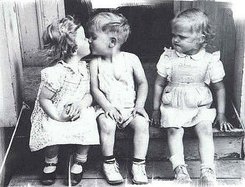
I’m guessing this explains why expressions ‘I felt like a fifth wheel’ and ‘Three’s a crowd’ have stood the test of time.
Based on that, one could jump to the conclusion that any two people would navigate the water of their relationship more easily than if there were three. Not so fast. Any time two people interact, there are actually three entities involved: Person A, Person B and the Relationship. The relationship is, in fact a separate and very powerful member of any alliance.
When I first heard this, I thought it could be far-fetched. However, as I have learned more I realize the truth in the idea that the relationship is its own distinct part in the connectedness of people. In fact, the relationship itself may last longer than either one of Person A or Person B.
Think about a relationship you have had that has ended. While either Person A or Person B may no longer be physically present, the relationship lingers and can even cause both grief and joy. We can easily think of two people who are individually both wonderful, but whose relationship is not healthy. This is not necessarily because either person is flawed; it could simply be that the relationship is not serving either of them well. In the same way, people can look back with fondness on a relationship they might have had with someone who is no longer in their life. While the physical person may not be present, the relationship can still bring them great joy.
Similarly, unhealthy relationships that have ended between two people can bring great pain, even when the people are not physically linked anymore. The relationship can continue to influence feelings and behaviors.
When two people have a relationship with each other, and a third person is introduced to the mix, room must be made for both Person C and all the relationships; there is a relationship between Person A and B, between A and C, and between B and C. And then of course there is the elusive relationship between all three – no wonder there can be hiccups when three people collaborate!
When I am with a client who mentions that they are having even a minor difference of opinion with someone in their life, I love to work through the following exercise to help them find a new way to proceed. Coaching is never focused on how others can change to make us feel better; it is always focused on the client and the power they have over themselves.
In this exercise, I ask the client find three points they can use to make a triangle in whatever space they are in. I have them to chose one point, Point A, and to stand on it. This place represents their own point of view. As they stand at Point A, I have them describe the situation to me from their perspective. They are encouraged to get as passionate about their stance as they can. They are to stand firmly in their own position.
Once they feel they have expressed all their thoughts on the situation, I ask them to move to Point B. Point B represents the other player in the dispute. As they stand on Point B, they are to become Person B. From here they are to give the point of view of Person B as if they are Person B. It is important that they speak in the first person when they are talking. For instance, I ask them to say, ‘I think that ….’ rather than saying, ‘Well Person B would say….’ Once they have finished being Person B (you will be amazed at how well you can take on the persona of Person B; even children can do this), I always ask them to return to Point A to mention anything they might have missed the first time. (Sometimes Person B will have triggered a memory😊) Finally, they will have spoken everything they need to from both Points A and B and I ask them to move to Point C.
Point C is the point of view of the Relationship. I ask them to take on the role of the relationship. Specifically, I ask, ‘What is it that the relationship can see that has not been expressed’. And finally, I ask, ‘What does this relationship need?’. Usually at this point, you can hear a pin drop. All of the fight goes out of the person as they focus on the question. Many answers have been given; all have been valuable.
Once the point of view of the relationship has been heard I have the client return to Point A. As you will recall, this is their own point of reference. Once here I ask them, ‘Knowing what you now know, what is it you need to do?’ There has never been a time when the person cannot think of something they can do to help solve the dispute, to grow the relationship and to honour her or himself.
Once you start to think about relationships as entities separate from the people, it is very hard to think of them any other way.
As you move forward through this week, think of all the relationships you have guardianship over. Think of times that, had you considered what the relationship needed, you could have eased a lot of stress.
My inquiry for you this week is, ‘What does this relationship need?’
There are many, many relationships in any life. Book a coaching session for yourself, a group or your workplace to learn how to effectively nurture relationships to create the results you desire.


 RSS Feed
RSS Feed